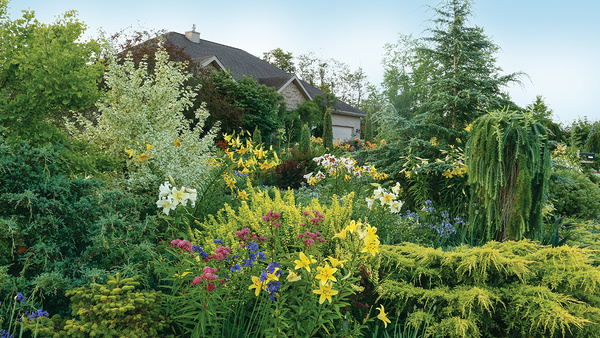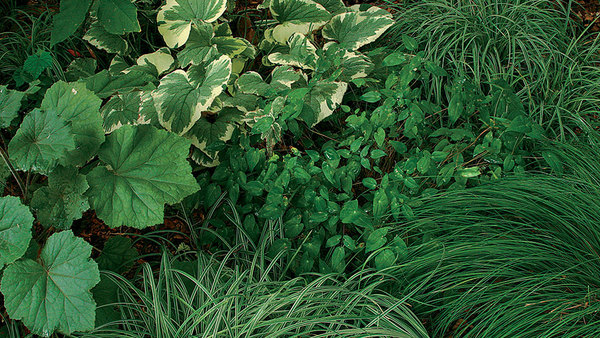
If you have ever visited New York City, you have most likely seen one of Lynden Miller’s gardens. From Central Park to the New York Botanical Garden, she has been instrumental in creating some of the city’s most memorable public gardens. Lynden Miller has proven that she knows what it takes to make a successful border. What is less known is that she refined her skills at home, where for the past 30 years she has worked on a 175-foot-long mixed border just outside her back door. Starting with an evergreen hedge as a backdrop, she has knitted together a composition of relatively familiar shrubs and perennials into a remarkable design. Here are some photos of her private garden.

1. Siebold’s hosta (Hosta sieboldii, Zones 3–9)
2. Variegated bishop’s weed (Aegopodium podagraria ‘Variegatum’, Zones 4–9)
3. ‘August Moon’ hosta (Hosta ‘August Moon’, Zones 3–9)
4. Common ladybells (Adenophora confusa, Zones 3–7)
5. Variegated Solomon’s seal (Polygonatum odoratum ‘Variegatum’, Zones 3–8)
6. ‘Blue Cadet’ hosta (Hosta ‘Blue Cadet’, Zones 3–9)
7. ‘Guacamole’ hosta (Hosta ‘Guacamole’, Zones 3–9)
8. Masterwort (Astrantia major, Zones 4–8)
9. ‘Aureola’ Japanese forest grass (Hakonechloa macra ‘Aureola’, Zones 5–9)
10. Yellow wax-bells (Kirengeshoma palmata, Zones 5–8)

1. Persicaria (Persicaria sp., Zones 3–8)
2. Golden Japanese barberry (Berberis thunbergii ‘Aurea’, Zones 5–8)
3. Euphorbia (Euphorbia sp. , Zones 4–11)
4. Golden spirea (Spiraea thunbergii ‘Ogon’, Zones 5–8)
5. ‘Blue Arrow’ juniper (Juniperus virginiana ‘Blue Arrow’, Zones 3–9)
6. Queen Anne’s lace (Daucus carota , Zones 3–9)
7. Daylily (Hemerocallis cv. , Zones 3–10)

1. ‘Lidakense’ cliff sedum (Sedum cauticola ‘Lidakense’, Zones 5–9)
2. Miss Willmott’s ghost (Eryngium giganteum , Zones 4–9)
3. ‘Vardar Valley’ boxwood (Buxus sempervirens ‘Vardar Valley’, Zones 6–8)
4. Juniper (Juniperus sp. , Zones 2–9)
5. Variegated miscanthus (Miscanthus sinensis ‘Variegatus’, Zones 4–9)
6. ‘Plum Pudding’ heuchera (Heuchera ‘Plum Pudding’ , Zones 4–9)
7. Purple coneflower (Echinacea purpurea, Zones 3–9)
8. Cordyline (Cordyline australis cv., Zones 10–11)
9. ‘Crimson Pygmy’ Japanese barberry (Berberis thunbergii ‘Crimson Pygmy’, Zones 5–8)
10. Golden spirea (Spiraea thunbergii ‘Ogon’, Zones 5–8)
11. Blue oat grass (Helictotrichon sempervirens, Zones 4–9)

1. ‘Rose Glow’ Japanese barberry (Berberis thunbergii ‘Rose Glow’, Zones 5–8)
2. ‘Blue Horizon’ ageratum (Ageratum houstonianum ‘Blue Horizon’, annual)
3. Juniper (Juniperus sp., Zones 2–9)
4. Flowering tobacco (Nicotiana langsdorffii, annual)
5. ‘Vardar Valley’ boxwood (Buxus sempervirens ‘Vardar Valley’, Zones 6–8)
6. Purple coneflower (Echinacea purpurea, Zones 3–9)
7. Miss Willmott’s ghost (Eryngium giganteum, Zones 4–9)
8. ‘Lidakense’ cliff sedum (Sedum cauticola ‘Lidakense’, Zones 5–9)

1. ‘Claridge Druce’ hardy geranium (Geranium × oxonianum ‘Claridge Druce’, Zones 4–8)
2. ‘Crimson Pygmy’ Japanese barberry (Berberis thunbergii ‘Crimson Pygmy’, Zones 5–8)
3. ‘Glowing Embers’ hydrangea (Hydrangea macrophylla ‘Glowing Embers’, Zones 6–9)
4. Ribbon grass (Phalaris arundinacea, Zones 4–9)

1. ‘Bright Eyes’ garden phlox (Phlox paniculata ‘Bright Eyes’, Zones 4–8)
2. Culver’s root (Veronicastrum virginicum, Zones 4–8)
3. Blue oat grass (Helictotrichon sempervirens, Zones 4–9)
4. ‘Claridge Druce’ hardy geranium (Geranium × oxonianum ‘Claridge Druce’, Zones 4–8)

1. Drumstick allium (Allium sphaerocephalon, Zones 4–11)
2. ‘Blue Horizon’ ageratum (Ageratum houstonianum ‘Blue Horizon’, annual)
3. ‘Autumn Joy’ sedum (Sedum ‘Autumn Joy’, Zones 3–11)
4. Balfour’s impatiens (Impatiens balfourii, annual)
5. White musk mallow (Malva moschata ‘Alba’, Zones 3–8)
6. ‘Plum Pudding’ heuchera (Heuchera ‘Plum Pudding’, Zones 4–9)
7. Purple coneflower (Echinacea purpurea, Zones 3–9)

1. Juniper (Juniperus sp., Zones 2–9)
2. Chinese rhubarb (Rheum palmatum ‘Atropurpureum’, Zones 5–9)
3. Queen Anne’s lace (Daucus carota, Zones 3–9)
4. Golden Japanese barberry (Berberis thunbergii ‘Aurea’, Zones 5–8)
5. ‘Fireglow’ euphorbia (Euphorbia griffithii ‘Fireglow‘, Zones 4–9)
6. ‘Superba’ snakeweed (Persicaria bistorta ‘Superba’, Zones 4–8)
7. Blue oat grass (Helictotrichon sempervirens, Zones 4–9)

1. Feverfew (Tanacetum parthenium, Zones 4–9)
2. Cordyline (Cordyline australis cv., Zones 10–11)
3. Drumstick allium (Allium sphaerocephalon, Zones 4–11)
4. Miss Willmott’s ghost (Eryngium giganteum, Zones 4–9)
5. Purple coneflower (Echinacea purpurea, Zones 3–9)
6. ‘Plum Pudding’ heuchera (Heuchera ‘Plum Pudding’, Zones 4–9)
7. Golden spirea (Spiraea thunbergii ‘Ogon’, Zones 5–8)

















Comments
Your garden will be stunning! Looks like you have beautiful mature trees all around - just beautiful, google street view. Glad to have this article and recommendations. Thank you!
Different colors of flowers and plants make a garden more beautiful and wonderful to watch. I would like to share some more tips on it like different color of elements for making border. You may find some tips right here for writing paper for presenting the pros and cons of building a better border of a garden.
Log in or create an account to post a comment.
Sign up Log in